 More than a decade after its first release, Drupal 7 is still widely used across the web. It can be found powering civic engagement in government installations; managing vast amounts of content for faculty, students, and staff in educational institutions; and providing the digital backbone for many businesses and non-profit organizations. Many organization still use Drupal 7.
More than a decade after its first release, Drupal 7 is still widely used across the web. It can be found powering civic engagement in government installations; managing vast amounts of content for faculty, students, and staff in educational institutions; and providing the digital backbone for many businesses and non-profit organizations. Many organization still use Drupal 7.
According to Drupal.org, the biggest level of adoption came with Drupal 7. The problem: that product has been outdated for years. Eventually Drupal will close off support for Drupal 7 and when that happens, almost half of the Drupal sites will be unsupported. Do you want a website running on unsupported software?

The migration from version to version of Drupal is significant. Many organizations are converting from Drupal 7 to WordPress. We’re here to help with getting your Drupal 7 website ready to be reborn as a cutting edge WordPress website.
Migrating a website from Drupal 7 to WordPress can be a complex process, as the two content management systems (CMS) have different architectures and use different technologies. However, there are several tools and methods available that can help you move your content and functionality from Drupal to WordPress.
People ask: “Can you migrate from Drupal 7 to WordPress?” The answer: yes! There are DIY approaches and companies like Web321 offer support for the conversion process.
Here are some general steps you can follow to migrate your Drupal 7 website to WordPress:
It’s important to note that the exact steps for migrating from Drupal 7 to WordPress will depend on the specifics of your website and your desired outcome. If you are not comfortable with the technical aspects of the migration process, you may want to consider hiring a professional to handle the migration for you.
If you don’t know what your website is running, let us help.
Put your URL into the form below:
Drupal is a registered trademark of Dries Buytaert.
